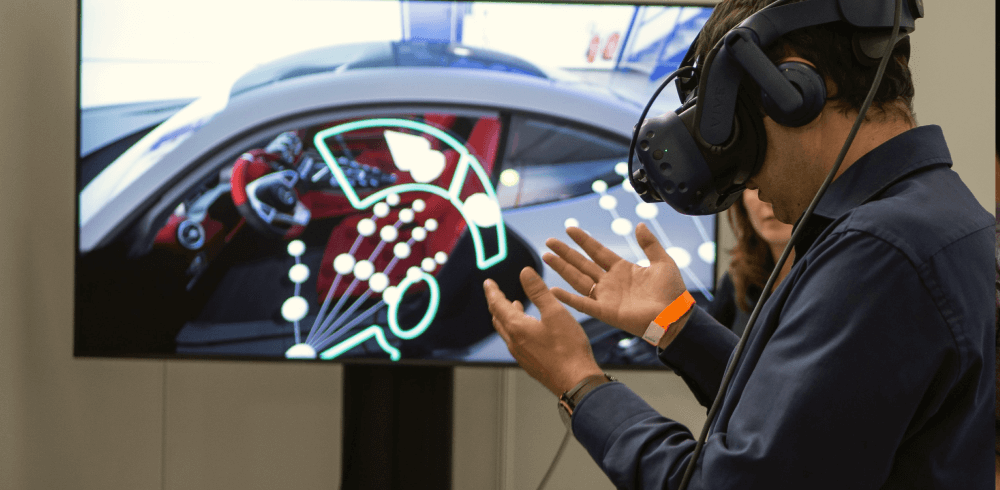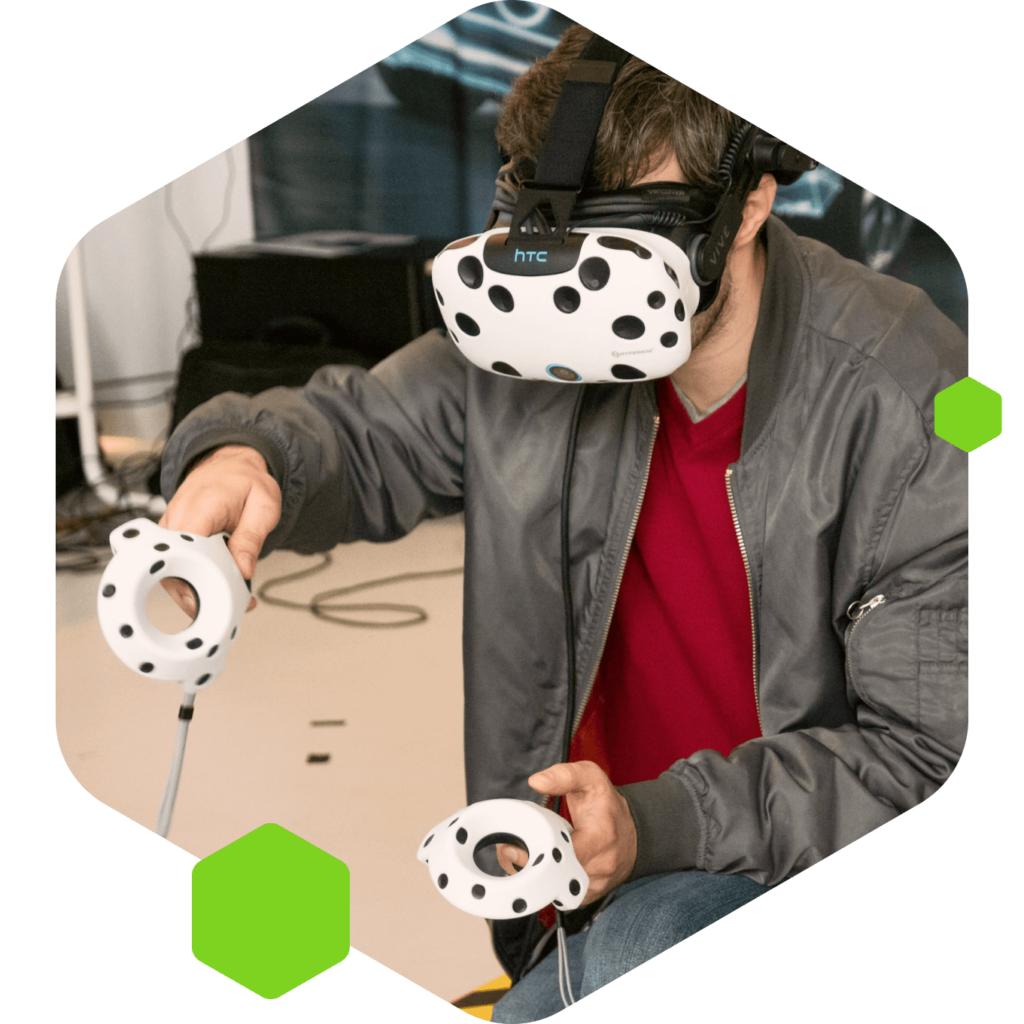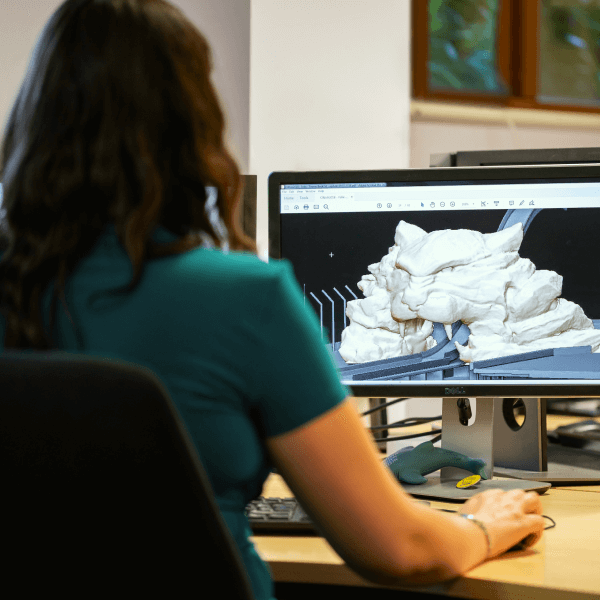Solutions
Virtual reality technology


About AR and VR
Augmented Reality (AR) and Virtual Reality (VR) are two types of immersive technologies that provide users with interactive and engaging experiences. They both use digital technology to create new realities, but in different ways.
AR involves overlaying digital information, such as text, images, and 3D objects, onto the user’s real-world environment. This can be done using smartphones or tablets, or dedicated AR devices such as smart glasses. AR is used in various industries such as education, healthcare, marketing, and entertainment, and is particularly useful in creating interactive and engaging experiences for users.
Let the revolution begin
VR, on the other hand, creates a fully immersive digital environment that users can interact with through a VR headset. This digital environment can be either real or imaginary and can be used for gaming, simulations, and training purposes. VR provides users with a sense of presence, allowing them to feel as if they are physically present in the virtual world.
Both AR and VR have the potential to revolutionize various industries and offer new ways of experiencing and interacting with digital content. However, they also come with unique challenges such as hardware limitations, the need for high-quality content creation, and potential motion sickness for users.

What is Virtual Reality (VR)?
Virtual Reality (VR) is a technology that creates a completely artificial environment, typically using a headset or glasses with screens in front of the eyes. The user is fully immersed in a digital world, and their movements are tracked by sensors to allow them to interact with the environment in a natural way. VR can be used for gaming, education, training, and many other applications. We have generally two main types of Virtual Reality (VR):
Non-Immersive VR. This type of VR uses a desktop computer or a mobile device with a screen to create a simulated environment. Users interact with the environment using a keyboard, mouse, or other input device. Non-immersive VR is typically less expensive and more accessible than immersive VR.
Immersive VR. This type of VR creates a fully immersive experience by using a Virtual Reality headset or other device that completely blocks out the real world and replaces it with a digital environment. Users can interact with the environment using specialized input devices, such as hand-held controllers or gloves with sensors. Immersive VR can provide a more realistic and engaging experience, but it can also be more expensive and require more powerful hardware.
Within these two main categories, there are also various subtypes of VR, such as:
- Room-scale VR. A type of immersive VR that allows users to move around a physical space while interacting with a virtual environment. Sensors track the user’s movements and adjust the virtual environment accordingly.
- 360-degree VR. A type of non-immersive VR that uses a 360-degree camera to capture an environment and allows users to view it from any angle.
- Web-based VR. A type of VR that allows users to access VR experiences through a web browser without the need for specialized software or hardware.
- Augmented Virtuality (AV). A type of VR that combines real-world elements with virtual elements to create a hybrid environment.
These are just a few examples of the many types of VR that exist. As VR technology continues to advance, new types of VR experiences are likely to emerge.
What is Augmented Reality (AR)?
Augmented Reality (AR), unlike Virtual Reality, overlays digital information into the existing real world environment. AR technology typically uses a camera-equipped device, such as a smartphone or tablet, to capture the user’s environment and add digital elements to it. This technology can be used for entertainment, advertising, education, and many other applications. We have four types of AR:
Marker-Based AR. This type of AR uses a visual marker or object as a reference point to overlay digital content. The camera in a device recognizes the marker and places the digital content over it. Examples of marker-based AR include scanning a QR code to access additional information or playing AR games using a game board.
Markerless AR. Also known as location-based AR, this type of AR uses GPS, compass, and accelerometer sensors in a device to place digital content in a specific location. This type of AR is commonly used in navigation applications, where digital directions are superimposed onto the real-world environment.
Projection-Based AR. This type of AR projects digital content onto real-world objects, surfaces, or environments. Examples of projection-based AR include projecting an image onto a building or projecting a virtual keyboard onto a table.
Superimposition-Based AR. This type of AR replaces a part of the real-world environment with digital content. This type of AR is commonly used in applications such as virtual try-on of clothing and makeup or furniture placement in a room.
Some AR applications may use a combination of these types to create a more immersive and interactive experience.
Mixed Reality
AR and VR technologies are often used together in a mixed reality (MR) experience, where digital objects are overlaid onto the real world, creating a hybrid environment (a compilation of computer generated virtual environment and real environment). These technologies have the potential to revolutionize the way we interact with digital information and enhance our experiences in the physical world.
Where Augmented Reality (AR) and Virtual Reality (VR) are used?
01
Product visualization
02
Virtual product demos
03
Brand storytelling
04
Virtual events
05
Location-based marketing
Augmented Reality (AR) and Virtual Reality (VR) can be used in marketing and advertising in a variety of ways. Here are a few examples:
Product visualization. AR and VR can be used to give customers a better understanding of how a product works or looks. For example, furniture companies can use AR to allow customers to place digital versions of their furniture in their own homes to see how it would look.
Virtual product demos. VR can be used to create immersive product demos, allowing customers to experience the product in a more engaging and interactive way. For example, car manufacturers can use VR to allow customers to take virtual test drives of their vehicles.
Brand storytelling. AR and VR can be used to create immersive brand experiences that tell a story and engage customers. For example, museums can use AR to provide additional information about exhibits, while also making the experience more interactive.
Virtual events. AR and VR can be used to create virtual events that allow customers to experience a brand in a new and innovative way. For example, fashion companies can use VR to create virtual fashion shows, allowing customers to experience the brand’s latest collection in an immersive and interactive way.
Location-based marketing. AR can be used to create location-based marketing campaigns that provide customers with relevant information about nearby stores, products, or services.
Augmented Reality (AR) and Virtual Reality (VR) more use cases
Of course not only in advertising we can use VA and AR. Augmented Reality (AR) and Virtual Reality (VR) can be used in education and training in a variety of ways too. Here are some examples:
- Immersive simulations. VR can be used to create immersive simulations that allow learners to practice and apply skills in a safe and controlled environment. For example, medical students can use VR to simulate surgeries and other medical procedures, allowing them to practice without the risk of harming real patients.
- Virtual field trips. AR and VR can be used to take learners on virtual field trips, allowing them to explore new places and cultures without leaving the classroom. For example, students can use AR to visit historical landmarks and learn about their significance.
- Interactive textbooks. AR can be used to create interactive textbooks that allow learners to access additional information and media by scanning images with their device. For example, students can scan a page in their textbook to access a video that provides additional context and explanation.
- Remote learning. AR and VR can be used to create immersive remote learning experiences, allowing learners to interact with each other and with virtual content from anywhere in the world. For example, language learners can use VR to practice conversational skills with native speakers from different countries.
- Skills training. AR can be used to provide on-the-job training for a variety of skills, such as manufacturing or repair. For example, workers can use AR to overlay digital instructions on real-world objects, allowing them to perform tasks more efficiently and accurately.

Are you looking for developers able to visualize your idea and create a virtual world?
Contact us!
Tools and technologies used to develop AR and VR applications
There are several tools and technologies used to develop Augmented Reality (AR) and Virtual Reality (VR) applications. Here are some of the most common ones:
- Game engines. Game engines, such as Unity and Unreal Engine, are commonly used to develop both AR and VR applications. They provide a range of tools and features, including 3D modeling, physics simulations, and scripting capabilities.
- SDKs and APIs. Software Development Kits (SDKs) and Application Programming Interfaces (APIs) provide developers with pre-built tools and components for building AR and VR applications. Examples include the ARKit and ARCore SDKs for AR, and the Oculus and SteamVR APIs for VR.
- 3D modeling software. 3D modeling software, such as Blender and Autodesk Maya, are used to create the 3D models and animations that are used in AR and VR applications.
- Tracking technologies. AR and VR applications rely on tracking technologies to accurately track the position and orientation of the user and any virtual objects. Examples include GPS for location-based AR, and optical tracking and sensors for VR.
- Web-based AR and VR platforms. There are several web-based platforms, such as A-Frame and AR.js, that allow developers to create AR and VR applications using web technologies such as HTML, CSS, and JavaScript.
- Hardware. AR and VR applications require specialized hardware, such as AR glasses and Virtual Reality headsets, to provide users with an immersive experience.
Programming languages used in Augmented Reality (AR) and Virtual Reality (VR)
There are several programming languages that are important in the development of Augmented Reality (AR) and Virtual Reality (VR) applications. Here are some of the most common ones:
- C#. C# is a popular programming language used with the Unity game engine, which is commonly used for developing both AR and VR applications.
- JavaScript. JavaScript is commonly used with web-based AR and VR platforms, such as A-Frame and AR.js.
- C++. C++ is used in the development of the Unreal Engine, which is another popular game engine for AR and VR development.
- Python. Python is often used in the development of computer vision algorithms, which are important in AR and VR applications that require object detection and tracking.
- Java. Java is used in the development of Android-based AR and VR applications, which are commonly developed using the ARCore SDK.
- Objective-C and Swift. Objective-C and Swift are used in the development of iOS-based AR and VR applications, which are commonly developed using the ARKit SDK.
- Shader languages. Shader languages, such as GLSL and HLSL, are used to create the visual effects used in AR and VR applications, such as lighting and shadows.
These are just a few examples of the many programming languages used in the development of AR and VR applications. The choice of programming language will depend on the specific requirements of the application being developed, as well as the platform and tools being used.

Przemek
COO

Damian
Business Representative

Piotr
Business Representative
